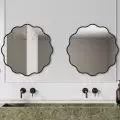The season for thermal modernization work has started in full swing. Thanks to, among other things, grants from the government's "Clean Air" program, thousands of Poles will insulate their homes this year. A large proportion will choose mineral wool for this purpose, which not only provides warmth in winter and pleasant coolness in summer, but is also characterized by high vapor permeability and guarantees safety during a fire.
When considering a specific product, it is worth paying attention to the value of the declared thermal conductivity coefficient, which is written with the symbol λD (lambda). It denotes the declared value, established on the basis of test results and measurements, and has a direct bearing on the insulation parameters of wool and thus the energy efficiency of the building.
Isover mineral wool
Photo: Piotr Ślursarczyk © FRB Ślusarczyk | Isover
low lambda = better thermal insulation
Lambda (λ) is the thermal conductivity coefficient expressed in W/(m*K) (watts per meter times kelvin), which indicates how much heat will flow through 1 square meter of uniform material 1 meter thick in one second at a temperature difference of 1 kelvin. In the context of comparing different products, declared lambda, derived from a series of measurements and rounded up, is particularly important. On the Polish market there are mineral wools, whose declared heat transfer coefficient ranges from 0.030 to 0.039 W/(m*K).What is the difference between the two?
- The rule of thumb regarding the lambda coefficient is simple: the lower its value, the better the insulation performance and more effective temperature retention inside the building. On the other hand, a high lambda for the same thickness of material can mean that, depending on the temperature outside, the interior of the building will cool down or heat up faster. This, in turn, translates into a deterioration in the thermal comfort of the home, increased heating or cooling bills and higher CO₂ emissions. Thermal insulation of the house, especially in the context of the ever-increasing prices of energy and heating fuels, is an investment for many years, so it is all the more worth betting on top-quality solutions with excellent physical properties. An example is the ISOVER brand products, which have the lowest declared thermal conductivity coefficient available on the market, amounting even to 0.030 W/(m*K), explains Marlena Madek, an expert at ISOVER, a leader in the production of comprehensive insulation solutions for construction, industry and energy.
Isover mineral wool
Photo: Ireneusz Sabat © URB Ireneusz Sabat | Isover
Where every centimeter counts
Importantly, by using wool with a lower thermal conductivity coefficient, we can reduce the thickness of the insulation layer while maintaining the same thermal properties. This means that a thinner layer of low lambda wool can protect against heat loss just as well as a thick layer of high lambda material.
- Due to their thinner thickness compared to inferior solutions, insulations with a low declared thermal conductivity coefficient are recommended for, among other things, insulating usable attics, where every extra centimeter of height translates into greater comfort in the space. A thinner thermal insulation layer in the case of exterior walls also provides the building with a more aesthetic appearance, thus avoiding the impression of a "fortress house." The issue of aesthetics can also be of great importance in the case of buildings under the protection of the conservator of monuments," explains Marlena Madej, ISOVER expert.
Isover mineral wool
photo: Dariusz Kuczpioł | Isover
Thus, the use of wool with a low declared lambda coefficient, e.g. 0.030 W/(m*K), i.e. excellent insulation properties, makes it possible to reduce the thickness of the insulation layer. This has the effect of increasing the cubic capacity of the room, while ensuring lower heating bills in winter, but also no overheating in summer. For this reason - especially when taking advantage of subsidies under the "Clean Air" program - it is worth choosing verified products from proven manufacturers, included in the list of green equipment and materials (ZUM), which provides assistance to program applicants in selecting equipment and materials eligible for subsidies.
For more information, visit the Saint-Gobain Construction Products Polska Sp. z o.o. website. ISOVER on the PdA portal.
























